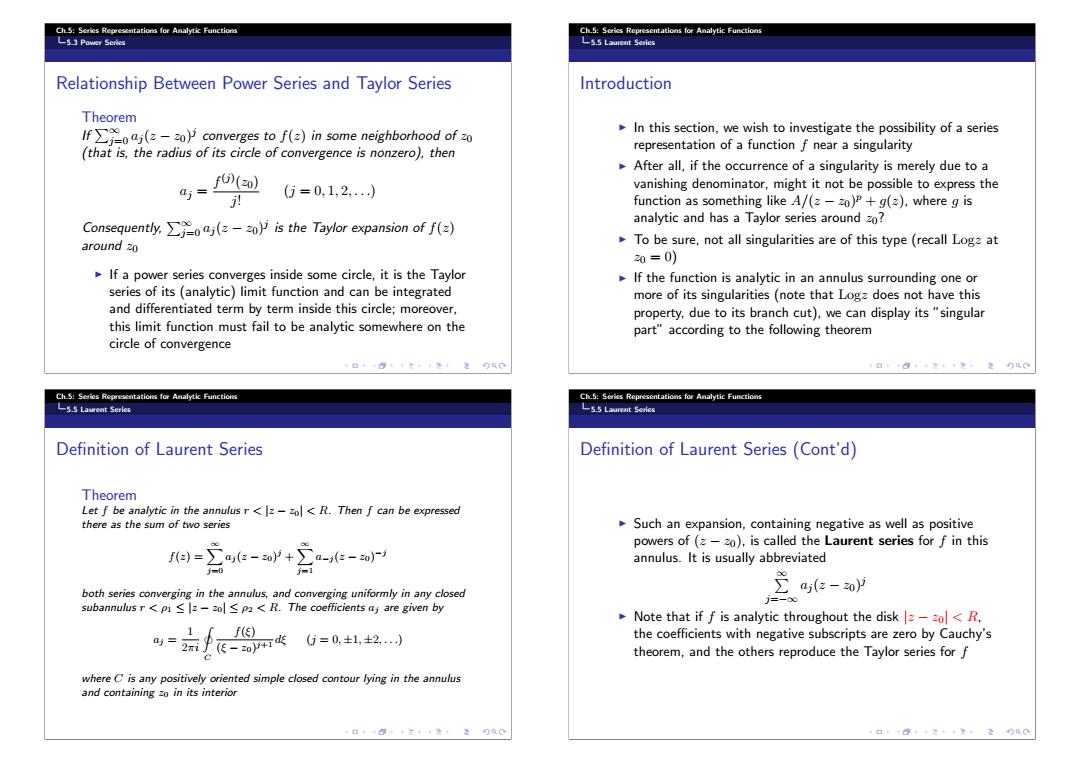正在加载图片...

Ch.5:Series Representations for Analytic Functions Ch.5:Series Representations for Analytic Functions L5.3 Power Series L5.5 Laurent Series Relationship Between Power Series and Taylor Series Introduction Theorem Ifj(-z)i converges to f(z)in some neighborhood ofzo In this section.we wish to investigate the possibility of a series (that is,the radius of its circle of convergence is nonzero),then representation of a function f near a singularity After all,if the occurrence of a singularity is merely due to a aj= f)(zo) (0=0,1,2,) vanishing denominator,might it not be possible to express the function as something like A/(z-z0)P+g(z),where g is Consequently,()is the Taylor expansion of f(=) analytic and has a Taylor series around zo? around zo To be sure,not all singularities are of this type(recall Logz at 20=0) If a power series converges inside some circle,it is the Taylor If the function is analytic in an annulus surrounding one or series of its (analytic)limit function and can be integrated more of its singularities(note that Logz does not have this and differentiated term by term inside this circle;moreover, property,due to its branch cut).we can display its "singular this limit function must fail to be analytic somewhere on the part"according to the following theorem circle of convergence Ch.5:Series Representations for Analytk Functions Ch.5:Scrics Representations for Analytic Functions 七5.5 Laurent Serics 5.5 Laurent Series Definition of Laurent Series Definition of Laurent Series (Cont'd) Theorem Let f be analytic in the annulus r<z-zo<R.Then f can be expressed there as the sum of two series Such an expansion,containing negative as well as positive powers of (z-z0),is called the Laurent series for f in this annulus.It is usually abbreviated both series converging in the annulus,and converging uniformly in any closed ar(:-y j=-0 subannulusr p <-zo<pa R.The coefficients aj are given by Note that if f is analytic throughout the disk z-zo<R, 1f) aj= 2m1-20* G=0,±1,±2,) the coefficients with negative subscripts are zero by Cauchy's theorem,and the others reproduce the Taylor series for f where C is any positively oriented simple closed contour lying in the annulus and containing zo in its interiorCh.5: Series Representations for Analytic Functions 5.3 Power Series Relationship Between Power Series and Taylor Series Theorem If ∞j=0 aj (z − z0)j converges to f(z) in some neighborhood of z0 (that is, the radius of its circle of convergence is nonzero), then aj = f(j)(z0) j! (j = 0, 1, 2,...) Consequently, ∞j=0 aj (z − z0)j is the Taylor expansion of f(z) around z0 If a power series converges inside some circle, it is the Taylor series of its (analytic) limit function and can be integrated and differentiated term by term inside this circle; moreover, this limit function must fail to be analytic somewhere on the circle of convergence Ch.5: Series Representations for Analytic Functions 5.5 Laurent Series Introduction In this section, we wish to investigate the possibility of a series representation of a function f near a singularity After all, if the occurrence of a singularity is merely due to a vanishing denominator, might it not be possible to express the function as something like A/(z − z0)p + g(z), where g is analytic and has a Taylor series around z0? To be sure, not all singularities are of this type (recall Logz at z0 = 0) If the function is analytic in an annulus surrounding one or more of its singularities (note that Logz does not have this property, due to its branch cut), we can display its ”singular part” according to the following theorem Ch.5: Series Representations for Analytic Functions 5.5 Laurent Series Definition of Laurent Series Theorem Let f be analytic in the annulus r < |z − z0| < R. Then f can be expressed there as the sum of two series f(z) = ∞ j=0 aj (z − z0)j + ∞ j=1 a−j (z − z0)−j both series converging in the annulus, and converging uniformly in any closed subannulus r<ρ1 ≤ |z − z0| ≤ ρ2 < R. The coefficients aj are given by aj = 1 2πi C f(ξ) (ξ − z0)j+1 dξ (j = 0, ±1, ±2,...) where C is any positively oriented simple closed contour lying in the annulus and containing z0 in its interior Ch.5: Series Representations for Analytic Functions 5.5 Laurent Series Definition of Laurent Series (Cont’d) Such an expansion, containing negative as well as positive powers of (z − z0), is called the Laurent series for f in this annulus. It is usually abbreviated ∞ j=−∞ aj (z − z0)j Note that if f is analytic throughout the disk |z − z0| < R, the coefficients with negative subscripts are zero by Cauchy’s theorem, and the others reproduce the Taylor series for f��������������